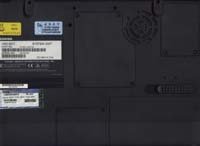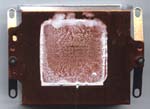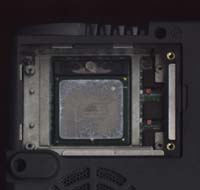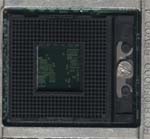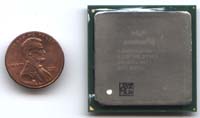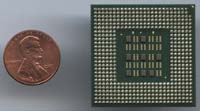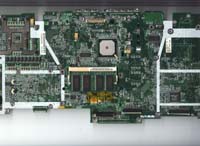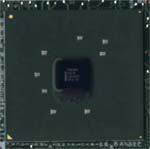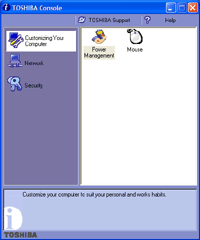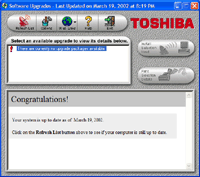
Original Link: https://www.anandtech.com/show/894
Toshiba Satellite 1905-S277 Notebook
by Matthew Witheiler on March 29, 2002 4:56 AM EST- Posted in
- Laptops
Notebooks come in a variety of sizes. Long gone are the days where notebooks came in one size: large and luggable Advancements in technology have produced a full range of notebook sizes. For those out there looking for maximum portability, the are the so called "sub-notebook" class computer sacrifice high power and high speed components for size. The continued miniaturization of computer components has made is possible to find full fledged computers that rival the size of yesterdays PDAs.
A second class of notebooks is the "thin and light" class; notebooks that typically strike a balance between size and speed. Think of these notebooks as desktops on a diet, often incorporating somewhat speedy processors but leaving out larger notebook extras such as internal drives and large displays.
The final broad category that notebooks can be placed in is the "desktop replacement" category. Desktop replacement notebooks generally sacrifice very little when it comes to speed. Instead of focusing on a slim design or light weight, desktop replacements strive to do exactly what their name implies: replace that large computer at your desk for something a bit more manageable. Desktop replacement notebooks are bigger and bulkier than the other notebook classes, but they are typically more feature rich and powerful.
Deciding which type notebook for you is a personal decision. For example, users who travel a good amount may be most comfortable with a sub-notebook: they may not be the fastest of the bunch, but they are sure easy on the back. On the other side of the spectrum are power users who do not anticipate moving their notebook a good amount. For these users, the desktop replacement class notebooks seem like the best fit.
You may recall that in our last notebook review we took a look at ASUS' T9, a notebook that can be classified as a fairly bulky thin and light notebook. In today's review we take a look at our first true desktop replacement notebook: Toshiba's Satellite 1905-S277. Featuring a desktop Pentium 4 processor, 256MB of memory, and a Mobility Radeon graphics chip we set out to determine if the Satellite 1905-S277 can really replace your desktop.
Construction - Build, Appearance, Size
Toshiba is one of the better known names in the notebook industry. The company's market share typically falls somewhere in the top five notebook producers, making it a major player in the notebook arena. Toshiba is known for producing high quality, relatively cutting edge systems that are backed by good customer support and warranty options.
As a large notebook producer, Toshiba's notebook line is expansive and includes notebooks in every size class. The Satellite 1900 series notebook that we look at today is tagged by Toshiba as "Power, performance and style for less than $2000" and the perfect solution for "customers wanting the capabilities of a desktop PC in a mobile design for an affordable price."
To fit the "capabilities of a desktop PC" into a mobile package, Toshiba was forced to build a rather bulky machine. The casing of the Satellite 1905-S277 is entirely plastic with a black, dark blue, and silver color motif. For the most part, the bottom half of the notebook is black and the top half dark blue. Silver plastic is used for accents and is found on the front face plate and the rear speakers.

To open the notebook, one simply needs to slide the front latch to the right and lift up on the screen. Doing so shows the Satellite 1905-S277's full sized 85 key and 12 function key semitransparent keyboard. The keyboard offers a 2.7mm key stroke and a 6mm height; two specs that made it quite comfortable to type on, in fact it has the feel of a desktop keyboard. The keyboard features dedicated home, page up, page down, and end keys as well as a set of dedicated arrow keys. As stated before, we have found that the inclusion of these keys results in increased efficiency as the user is not forced to hit a series of keys to perform a simple function.
The keyboard is located 4.5 inches from the front of the laptop, leaving ample space for wrist support. The touchpad style pointing device is located pretty much in the dead center of the wrist space which made it a bit less comfortable than the offset touch pad on the ASUS T9. Then again, left handers out there will have an easier time using the centered touchpad.
The front panel of the laptop is home to both a series of LEDs as well as CD controls. These controls and lights are angled outward so that they are completely visible and accessible when the notebook is closed. The LED panel is located directly in the middle of the front panel and has green LED lights for: AC power, power on, battery status, hard disk access, and disk activity light for the internal floppy and DVD-ROM/CDRW. Both the battery light and the power light have the ability to change from green to amber. The battery light glows amber while the battery is being charged and the power light flashes amber when the system is in standby mode.
To the right and left of the LCD panel are 5 buttons used to control the internal CD-ROM drive both while the system is on and while it is off. The first button on the left, the "mode" button, is used to enable or disable the other CD control buttons. Holding the mode button down for 4 seconds lights up a CD-ROM LED that is at the left most position on the LED display panel With this light on, the forward, back, play/pause and stop buttons can be used to control the CD player. The DVD-ROM/CDRW drive can be opened while the power is off as well, meaning that the system is usable as a full CD player even while the power is off. We found this to be quite a useful feature, as it allowed us to listen to our audio CDs while sparing the battery drain that accompanies listening to a CD with the system fully powered up.
At the top of the keyboard, between the number keys and the function keys, lies two additional LEDs. The first of these two LEDs is the "cursor control mode light" which comes on when function-F10 is hit. This light indicates that the number pad (indicated by small gray letters beneath a set of keys) is on for directional control noted by the leftmost gray letters. The other light, enabled by hitting function-F11, indicates that the number pad is on for the numbers on the controls (the rightmost gray letters). The caps lock key light is located beneath the caps lock button so the left side of the key lights green when caps lock is on.
Above the keyboard one finds the silver power button as well as a tiny rubber nipple that is used as a switch to turn off the screen when the display is closed. On the left and right hand side of the top of the notebook are the system's speakers. The LCD is mounted by brackets on both sides of the system and opens and closes with ease.
Being a desktop replacement system, the Satellite 1905-S277 contains quite a few built in features. As we already mentioned, the front of the notebook is home to the LED and CD-ROM control panels. Moving to the left side of the notebook we find two PCMCIA slots that support two type II or one type III PC cards. Above the PCMCIA slots are the audio controls and outputs. The Satellite 1905-S277 has a dial style volume control as well as microphone and headphone 3.8mm jacks. To the left of these components is the system exhaust port. Located directly in front of the CPU, the exhaust blows across the CPU's heatsink and out here. As one would suspect, the 0.18 micron 1.6GHz Pentium 4 that the Satellite 1905-S277 makes use of gets rather hot. We were able to get the exhaust temperatures up to 126.9 degrees Fahrenheit (52.7 degrees Celsius) while testing.
Moving to the back of the system we can see that the speaker grilles extend a good amount towards the back. Located directly below the left speaker on the back is another exhaust port. Since airflow passes over the heatsink from right to left, we found that the air out the left vent was typically stronger and hotter than the air out of the rear vent. In fact, we could not even feel any air flow across the rear vent. The next item on the system's back is the video-out port which appears to be capable of outputting to both s-video as well as composite connections via a dongle but none was provided in the box. The port does accept an s-video cable without a hitch, however. To the left of the video-out port is the AC adapter port, followed by a 15-pin VGA-out port, a parallel port, a modem port, and an ethernet network port. Rounding off the back are two USB ports located side by side and a security lock slot.
The right side of the system holds all the removable media drives. First off is the semi-removable 24X CD-ROM, 4X CD-R and CD-RW, and 6X DVD-ROM combo drive. The reason that this is semi-removable is because one has to remove the memory expansion cover to get to the screw that holds the drive in place. Next to the drive is another vertical USB port, followed by a semi-removable internal 3.5" floppy drive. Again the floppy drive is semi removable because to get it out requires the removal of the hard drive as well as a locking screw at the base of the floppy drive.
The bottom of the system is home to quite a few expansion slot covers. The rectangular slot in the middle of the front of the Satellite 1905-S277's bottom is the hard drive cover and is easily removed by releasing two Philips head screws. To the right of the hard drive cover is the battery pack which can be released by sliding the lock lever from right to left. Behind the hard drive cover is the memory expansion slot cover. The cover located in the back right corner of the system is home to the CPU. This cover is held in place by two T-6 Torx screws and can only be removed with a T-6 screw driver. Between the memory expansion slot cover and the CPU cover is the fan intake port which is grated to prevent any large objects from getting sucked into the cooling system. With the system running, we were able to get the bottom right side of the Satellite 1905-S277 up to 103.1 degrees Fahrenheit (39.5 Celsius).
With all the built in components that the Satellite 1905-S277 features, it is not too big of a surprise that the notebook is quite large. The system measures 13.2"x11.7"x2.0" and weighs a backbreaking 8.3 pounds. The Satellite 1905-S277 is certainly a heavy weight when it comes to notebooks, even desktop replacement ones.
Construction - Under the Hood
Being a desktop replacement notebook, there is quite a bit under the Satellite 1905-S277's case. The system we received was powered by a desktop 1.6GHz Intel Pentium 4 processor and featured 256MB of memory, a 30GB hard drive, an internal DVD-ROM/CDRW drive and an internal floppy drive.
Perhaps the most intriguing aspect of the Satellite 1905-S277 is the processor it uses. Make no mistake, the Satellite 1905-S277 uses a desktop Pentium 4 processor based on the Willamette core. That means that the notebook's CPU is built on a 0.18 micron architecture and has 256KB of integrated L2 cache and is thus different than the recently released Pentium 4-M chip. Unlike the Willamette based Pentium 4, the Pentium 4-M is manufactured on a 0.13 micron process and features 512KB of L2 cache just like the Northwood Pentium 4 chips..
Due to the chip's nature, the Willamette Pentium 4 that the Satellite 1905-S277 uses is not too well suited for notebook use. The chip uses quite a bit of power, produces a lot of heat, and does not feature mobile-only features such as SpeedStep technology. Also, since the technology is older, the Willamette Pentium 4 used in the Satellite 1905-S277 features less integrated L2 cache.
Using the desktop processor also necessitated the use of a desktop chipset. In this case Toshiba chose Intel's 845 chipset with an SDR memory bus. Once again, the chipset was designed for a desktop application and is different than Intel's mobile Pentium 4 chipset solution, the 845MP. Again, the Satellite 1905-S277 loses out by using desktop components: the 845MP features support for SpeedStep technology as well as DDR memory, features that the 845 does not offer.
The CPU is cooled via a fairly large copper heatsink that sits directly on top of the processor. Air flow across the heatsink's fins is provided by a fan mounted to the CPU's left. Air flows from left to right over the heatsink before exiting via the vent on the back left of the system.
Also cooled via this setup is the northbridge of the 845 setup, which is located directly under the cooling fan.
Removing the CPU was easy, if you have the right tools. To get the panel off the CPU cover, we had to use a T-6 screw driver to remove two small Torx screws. Once the panel was lifted off, the heatsink was exposed. This too was easily removed by releasing a set of four Philips head screws around the CPU.
As you can see, the CPU sits in a Molex type socket that allowed for easy removal of the processor with a simple twist of a screw.
The one main advantage to using a desktop CPU and chipset in a notebook is that the CPU is easily upgraded, provided that the system's BIOS offers support for higher speed processors. It is much easier to get your hands on a faster desktop processor than it is to get access to a faster mobile one. We tested to see how our Satellite 1905-S277 responded to a CPU switch by placing a 2.0GHz Willamette into the system's socket. Lo and behold, the 2.0GHz processor worked without a hitch: making for a very quick and easily accessible way to increase system performance. Although we did not get the opportunity to test the notebook with a newer Northwood based Pentium 4, we highly doubt that the system will work with the newer processor. We will be sure to try things out soon and change things if appropriate.
There are two things to keep in mind when upgrading your notebook's CPU. First off, going to a higher clock speed typically means sacrificing some battery life. This is especially true in the case of the desktop processor used in the Satellite 1905-S277, as it will run at its maximum speed regardless of power state (AC or battery). The other thing to be careful of is heat. The cooling system employed in a notebook can be dependent on how fast a company intended to take the notebook. If the cooling system on the Satellite 1905-S277 is only sufficient to cool the 1.6GHz chip it ships with, replacing the chip with a 2.0GHz one may cause the system to over heat. Although we did not experience any problem with this in our tests, it is something to keep your eye on.
The 845 chipset that the Satellite 1905-S277 ships with is identical to the desktop model. This means that the system features support for PC133 SDRAM memory, has a 4X AGP bus, includes support for the three USB ports on the notebook, supports the Ultra ATA/100 specification, and offers AC97 sound support.
An ATI Mobility Radeon chip powers the graphics system on the Satellite 1905-S277. Located on the back of the motherboard, the Mobility Radeon chip has a small metal heatspreader glued to its surface. The version of the Mobility Radeon found on the Satellite 1905-S277 includes 16MB of externally mounted 64-bit DDR memory and is clearly geared towards the 3D market. The graphics part is able to output at up to 1600x1200x32. For more information regarding the Mobility Radeon, be sure to check out our Mobility Radeon preview.
There are a few other components mounted on the back of the Satellite 1905-S277's motherboard. Directly below the Mobility Radeon chip is the system's 256MB of memory. The full 256MB of memory is mounted in the internal SODIMM slot
On the lower right of the motherboard is an SMSC LPL47N227 chip that is used for the super I/O functions of the notebook including the floppy, parallel, and serial port controllers. Other than the graphics chip, the memory and the super I/O controller, the backside of the Satellite 1905-S277 is fairly bare. The remainder of the components are located on the front of the motherboard.
Let's start with the right side of the system and work our way across. At the top right of the motherboard is the CPU socket with the cooling fan located to its left. Underneath the cooling fan lies the Intel 82845 memory controller hub (or northbridge).
Below this assembly is a Texas Instruments PCI1420GHK PCMCIA controller chip. To the left of the cooling fan is a proprietary Wi-Fi connector that accepts Toshiba's factory installed 802.11b solutions. Below this is the user accessible memory expansion SODIMM slot.
Moving to the left again we find the 16MB of video memory. Toshiba used 5.0ns Samsung VRAM (video memory). Note that the location of the memory, on the opposite side of the motherboard, required Toshiba to implement costly cross PCB traces. It seems that this was the best place to locate the memory, however.
Below the video memory is a O2Micro OZ168T chip. This is the chip that allows the notebook to play audio CDs while the power is off, as the OZ168T takes control of the CD-ROM drive when the front control buttons are used with the system powered off.
To the left of the memory and the O2Micro chip is the Intel FW82801BA I/O controller hub (south bridge) that provides support for the PCI bus, the USB interfaces, the AC97 audio codec, and the UDMA controller among other things.
The final noteworthy item on the front of the motherboard is the National Semiconductor PC87591S controller. Although we are not certain what function this chip serves, it is capable of managing ACPI functions as well as providing PS/2 control support, hardware monitoring, and digital to analog conversions.
The Satellite 1905-S277 used a 30.0GB Toshiba 3017GAP hard disk that spins at 4200RPM and fits the 9.5mm form factor. The drive supports the ATA-100 specification and has a 13ms average seek time. This drive is slower than other hard drives in the Toshiba lineup with a longer average seek time.
For sound, the Satellite 1905-S277 uses two speakers mounted raised above the keyboard on the right and left sides. The speakers sounded fairly good as far as laptop speakers were concerned. Although volume did not get very loud, there was not much distortion at the volume the speakers did play at. It seems like Toshiba's relatively unique design paid off.
While on battery, the notebook gets its power from a 12-cell 5850mAh lithium ion battery that outputs 87 watts. This is quite a powerful battery for a notebook system but fully necessary considering the power that the desktop Pentium 4 in the system needs.
Display-wise, the Satellite 1905-S277 makes use of a 15.0" XGA TFT screen. Although the graphics chip is able to output at up to 1600x1200, the TFT display is only capable of displaying resolutions at or below 1024x768x32. The screen was clear and crisp thanks in part to the Radeon RAMDAC as well as the quality TFT screen.
We were pleased with the ease that the Toshiba Satellite 1905-S277 provided when upgrading components. The system's hard drive and memory are easy accessible via a few Philips head screws. The CPU is just as readily accessible, this time through two Torx screws. Changing out many of the vital components should prove to be no problem later on.
Features - Software
We were fairly impressed with the Toshiba Satellite 1905-S277's software package. Most importantly, Toshiba did not skimp on the operating system. The Satellite 1905-S277 comes preloaded with Windows XP Home edition. The operating system proved to be a much better solution than the Windows 98, ME or 2000 solutions we have seen other laptops ship with. Don't worry, however, if you want to use another Microsoft operating system on your notebook drivers are available for download on Toshiba's website.
The system also came with Lotus SmartSuite Millennium Edition which provided office applications. Although Lotus SmartSuite is not nearly as accepted as the Microsoft Office suite, it does provide word processing, mail, and spread sheet functionality. Why include the latest edition of Lotus SmartSuite instead of the latest Microsoft Office suite with the Satellite 1905-S277? Although the retail prices of the two suites are relatively similar, the Lotus package clearly costs less for Toshiba to license. It was nice to have word processing functionality out of the box without having to drop a few more hundred dollars and although the package may not be as accepted as Office, it will get the job done for the most part.
Also on the office side of things, Toshiba includes Intuit Quicken Basic 2001 and Norton AntiVirus 2002. Quicken Basic 2001 is a stripped down version of Quicken that asks the user to upgrade every few clicks but should prove useful for those just learning the popular business program. Norton AntiVirus 2002 kept our system safe from viruses.
The software side of the DVD/CDRW combo drive is provided by two programs: Intervideo WinDVD 3 and Roxio Easy CD Creator 5. Both programs are among the best in the field at what they do, so it seems that Toshiba chose wisely.
Like other notebook manufacturers, Toshiba includes some custom utilities that control power management as well as set computer settings. The Toshiba Power Management Utility does exactly what its name suggests: controls the power management settings for the system. The utility not only allows the user to set monitor brightness, set when the monitor turns off, set hard drive spin down time, system standby time, and system hibernate time but it allows individual settings to be changed depending on remaining battery charge. For example, you can set the Satellite 1905-S277 to run at full monitor brightness while the battery is fully charged but at only half brightness when the battery drops below 50 percent. The program worked as advertised with the exception of the "Processor Speed" slider. Since our system used the desktop Pentium 4, processor speed could not be changed. Moving the slider from full to high to medium to low resulted in no performance change or processor clock change. It would have been nice if Toshiba grayed out the "Processor Speed" setting as to prevent confusion.
The Toshiba Console provided quick access to various window settings, such as mouse settings and power settings. Other than that, the utility did not offer much.
Finally, Toshiba includes a utility called "Software Upgrade." This utility checks Toshiba's web site for software updates including new drivers and new utilities.
The Test
|
Windows XP Professional Test System | |||||||
|
Hardware | |||||||
|
Toshiba
Satellite 1905-S277 |
Desktop
Testbed | ||||||
| CPU(s) |
1.6GHz
Intel Penitum 4 Willimatte |
1.6GHz
Intel Pentium 4 Willimatte | |||||
| Motherboard(s) |
Toshiba
845 SDR | ||||||
| Memory |
256MB PC133 |
256MB PC133
Corsair SDRAM | |||||
| Hard Drive |
30.0GB Toshiba 3017GAP |
IBM Deskstar
DPTA-372050 20.5GB 7200 RPM Ultra ATA 66 | |||||
| CDROM |
Toshiba DVD/CDRW |
Phillips
48X | |||||
| Video Card(s) |
ATI Mobility
Radeon 16MB DDR |
ATI Radeon
7000 64MB DDR | |||||
| Ethernet |
Intel PRO/100 Onboard Ethernet Adapter |
Linksys
LNE100TX 100Mbit PCI Ethernet Adapter | |||||
|
Software | |||||||
|
Operating System |
Windows XP Professional | ||||||
| Video Drivers |
|
ATI 7.65.04 | |||||
| Benchmarking Applications | |||||||
| Content Creation |
Bapco SysMark
2001 | ||||||
Note that system performance did not change at all depending if the system was on battery or AC power, since the desktop Pentium 4 chip that the notebook uses does not support speed step technology.
Performance - Overall Performance
We recently moved to the latest version of SYSMark, SYSMark 2002. Look for this benchmark to be used in upcoming notebook reviews, replacing SYSMark 2001. For more information on SYSMark 2002, check out BAPCo's white paper on the benchmark.
|
The Office Productivity SYSMark 2002 results should not be to surprising considering what we saw in our last notebook review. Although the Toshiba Satellite 1905-S277 is based on both a desktop chipset as well as a desktop CPU, it only performs at a desktop Pentium 4 1.3GHz level although the laptop chip is clocked at 1.6GHz.
This time around we can not blame a crippled system bus, as the Satellite 1905-S277 does not use shared memory for video buffer. We also cant blame the chipset or the CPU. It seems that the slower system performance in Office Productivity SYSMark 2002 can be attributed to only one thing: the slower hard drive used in the notebook system. We saw the same thing in the in the ASUS T9 notebook, as replacing the desktop system's hard drive with the notebook drive resulted in a large 15% performance decrease.
|
As a result of better performance in the SYSMark 2002 Internet Content Creation test (which we will look at next), the overall SYSMark 2002 score is higher than the score of the individual Office Productivity score. Here, the Toshiba Satellite 1905-S277 performed 10.2% slower than the desktop system at 1.6GHz. Overall in the SYSMark 2002 benchmark, the Satellite 1905-S277 performed essentially like a 1.4GHz desktop system.
Performance - Content Creation
|
Like we mentioned before, the notebook system did better in the Internet Content Creation part of SYSMark 2002 than it did in any other part. Here the Satellite 1905-S277 performed almost like the desktop Pentium 4 clocked at 1.5GHz, falling only 2.4% behind it.
Look at BAPCo's whitepaper on the benchmark, we can see that SYSMark 2002 is more I/O intensive than SYSMark 2001. This can explain why the Satellite 1905-S277 performed slower in comparison to the desktop Pentium 4 system than the ASUS T9 did in comparison to the desktop Pentium III system (as the ASUS review used SYSMark 2001).
|
We found in our last notebook review, the ASUS T9 review, that Content Creation Winstone 2002 is extremely I/O intensive and thus is typically problematic for notebook systems. The Toshiba Satellite 1905-S277's performance in this benchmark was actually not so bad, performing between the level of the desktop 1.3GHz system and the 1.4GHz one. The Satellite 1905-S277 performed 19% slower than the desktop 1.6GHz system.
Since we also ran the ASUS T9 notebook through the Content Creation Winstone 2002 tests, we included this notebook in the graph for comparison. As you can see, the Satellite 1905-S277 is clearly faster; in fact it is faster than the ASUS T9 on AC power by 61.5%.
Performance - BatteryMark 2001
|
We used BatteryMark 2001 to test the Toshiba Satellite 1905-S277's battery life and were quite impressed with the results. As the above graph shows, the Toshiba Satellite Satellite 1905-S277 ran for a full 3 hours and 59 minutes while on battery power. That equated to a run time of 239 minutes, meaning that it out lasted the thin and light ASUS T9 by 1 hour and 26 minutes. That is one advantage that desktop replacement notebooks offer: although they often draw more power, they also have the leeway to include powerful batteries. Like we mentioned before, the Satellite 1905-S277 uses a 12 cell battery that puts out 5850mAh of power.
Performance - Startup Times
|
As always, boot time of a notebook is important. Because of all the internal components that the Toshiba Satellite 1905-S277 must initialize upon boot, the system started 2 seconds slower than the ASUS T9 while it was on battery power. The DVD/CDRW drive and floppy drive are two items that the ASUS T9 did not need to initialize upon bootup.
After asking for feedback on our last notebook review, we found that many of our readers were also curious to see how long it took a given notebook to come out of standby and hibernate modes. The Toshiba Satellite 1905-S277 took only 6 seconds to come out of standby mode and 17 seconds to come out of hibernate mode. We will be sure to compare these numbers to the times it takes future notebooks to perform the same tasks.
Performance - Unreal Performance Test 2002
So the Satellite 1905-S277 uses a full 3D graphics chip with dedicated 64-bit DDR memory, making it beg to have games played on it. Let's see how the notebook did in 3 sets of games. To begin we will use Unreal Performance Test 2002 build 856. The game should give us an idea as to how the notebook compares to a similarly equipped desktop system using a Radeon 7000 graphics card (which is almost the equivalent to the Mobility Radeon, but more on that in a second). Although the benchmark is stressful, it gives a good idea of how a system will perform in future games.
|
At 640x480x32 it seems that the benchmark scales on CPU speed. The FPS in the game went down every time the desktop CPU was underclocked 100MHz. The Toshiba Satellite 1905-S277 performed slower than even the 1.3GHz Pentium 4 desktop, falling behind the 1.6GHz system by 16.9%. The performance of the system, at 20.7FPS, leaves quite a bit to be desired. Then again, the performance of the desktop system at 1.6GHz also leaves a lot to be desired.
|
Now we see where the video card has become a bottleneck. At 800x600x32, all of the desktop systems perform essentially the same thanks to the Unreal Performance Test stressing the video card to the max. You may notice, however, that the Toshiba Satellite 1905-S277 falls behind. Why?
Well, it is a result of the differences between the desktop Radeon 7000 (also known as the Radeon VE) and the mobile Mobility Radeon. Although both are based on the RV100 core, meaning they are 0.18 micron based and leave out both T&L support as well as HyperZ support, the two chips are different in two ways: in the amount of memory they have and the speed of the memory and the graphic core. The Mobility Radeon can accept up to 64MB of external 64-bit DDR memory, our Toshiba notebook only came with 16MB of video buffer. This really hurt the system as resolution was increased, as more complex scenes could not fit in the system's frame buffer. The Radeon 7000's 64MB of buffer was plenty to run the games we tested on.
The other difference is in clock speed. The Mobility Radeon is only clocked at a 166MHz core and a 166MHz memory bus speed. In comparison, the Radeon 7000 we used in the desktop system was clocked at a 183MHz core and a 183MHz memory clock. Both the increased speed as well as the increased frame buffer added together to produce the slow 3D scores we find throughout the remainder of the review.
|
Again, the Mobility Radeon is held back by its slower clock speeds and its smaller video buffer. The laptop system performed 21% slower than the desktop ones.
Performance - Serious Sam: The Second Encounter
|
Performance under Serious Sam: The Second Encounter at 640x480x32 varied slightly with clock speed. The Satellite 1905-S277 was left performing at 39.2FPS, making the game playable but somewhat choppy in complex scenes. The desktop 1.6GHz Pentium 4 with the Radeon 7000 at the helm performed 18.6% faster. Note that the game tests were performed at the default quality setting with all textures and color depths pushed up to 32bit. This is different than the Extreme Quality setting we typically test desktop systems on since we though that the default quality setting would level the playing field while not bringing frame rates to a crawl.
|
The desktop systems in this test perform similarly. The Satellite 1905-S277 was left behind, however, due to the aforementioned reasons. The notebook was 7% slower than the desktop 1.3GHz system but 12.5% slower than the 1.6GHz one.
|
Performance really took a dive when the resolution was cranked up to 1024x768x32. It was interesting to see the desktop systems perform similarly with the exception of the 1.3GHz system which simply could not keep up. This allowed the Satellite 1905-S277 to come within 3.4% of the desktop 1.3GHz system although it still lagged far behind the 1.6GHz one.
Performance - Return To Castle Wolfenstein
Return to Castle Wolfenstein is a fairway taxing game based off the Quake III Arena engine. Let's see how the notebook did in this fairly new game.
|
At 640x480x32 the desktop systems performed on relatively the same level. The one system left in the dust: the Toshiba Satellite 1905-S277. The drastic difference in performance in this instance is likely not so much due to the differences in clock speeds between the Radeon 7000 and the Mobility Radeon but rather due to the smaller frame buffer on the Mobility Radeon that we had. It seems that Return to Castle Wolfenstein is a texture intensive game and that the Toshiba laptop got penalized for its small frame buffer.
|
Again we see the same trend as we saw at 640x480x32: all the desktop systems performing the same but the Toshiba Satellite 1905-S277 falling behind. At 800x600x32, the notebook fell behind by a full 60%.
|
1024x768x32 seems to have put the Satellite 1905-S277 in the death grip. The system was only able to output 12.3FPS at this resolution, making it fall behind the desktop systems by 124%.
Conclusion
Desktop replacement notebooks are certainly not for everyone. Those who travel a lot, don't need a speedy system, and those who simply want to move from one location to another without much back strain should shy away from desktop replacement systems. Those who crave power, want to game on their laptop, and those who truly are looking for a replacement for their aging desktop are best suited for desktop replacement notebooks.
Toshiba has made a name for themselves in the notebook market. As one of the top five notebook brands in the country, they have quite an installed user base. One thing that helped Toshiba grow to the extent they did was by making laptops in almost every shape and size. Like the rest of the Satellite category notebooks, the Satellite 1905-S277 that we looked at here is a desktop replacement system for the power user.
We must say that despite the systems enormous size, we were fairly happy with it; happy, that is, as long as we didn't have to move it. The system is large, at two inches thick (that is twice as thick as many thin and lights) and 8.3 pounds, making it quite a pain to lug around, especially since no case is included standard. The large size, however, does offer many benefits.
First off, the ease at which the Satellite 1905-S277 can be upgraded is very convenient. To get more speed out of you system, all one needs to do is replace the current 1.6GHz desktop Pentium 4 CPU with a more powerful Willamette based one such as the 2.0GHz. When things start getting slow, it is nice to know that changing out the CPUs will not be a laborious task that requires finding a special notebook CPU.
When praising the desktop CPU that the Satellite 1905-S277 uses, one must also consider the recently announced Intel Pentium 4-M chip. Based on Northward technology, the Pentium 4-M is smaller, cooler, supports SpeedSteping, and faster than the Willamette Pentium 4 the Toshiba Satellite 1905-S277 uses. Unless you are looking for an easy way to upgrade your system in the future with a desktop component, it makes more sense to choose a Pentium 4-M based desktop replacement notebook.
Thanks to its weight the system was also able to have phenomenal battery life. Lasting only a minute shy of 4 hours, the Toshiba Satellite 1905-S277 should keep many happy even on long trips (as long as your back doesn't mind). It was also nice to know that the system's DVD/CDRW player and floppy disk drive will accompany you everywhere you take it, from LAN parties to long trips. And as far as extras go, the system's CD-player functionality was nice, as were the unit's impressive speakers.
The Satellite 1905-S277 is not without flaws other than the size, however. We had two major complaints when it came to the system: the hard drive and the video system. As a desktop replacement system, we would have expected to see a fast notebook hard drive at the heart of the Satellite 1905-S277. Instead, we found a relatively low end Toshiba drive. Although the system is priced in the entry desktop replacement range, it still would have been nice to have something a bit faster especially considering the bottleneck that the I/O system is in notebook computers.
On the video side, we were disappointed with the small 16MB frame buffer that the Satellite 1905-S277 came outfitted with. This really proved to be a thorn in the notebook's side when it came to game play. Considering the size of the system and the fact that it touted as a desktop replacement, upping the frame buffer to 32MB would have helped a lot. Although the Mobility Radeon is not the latest generation mobile product from ATI, it would have performed better with the additional 16MB of memory.
If you are looking for a desktop replacement notebook to perform office tasks with, the Toshiba Satellite 1905-S277 will likely not disappoint. With it's desktop based Pentium 4, upgrading should prove to be no problem as long as you avoid the Northwood core. The system was plenty speedy in our tests and should not disappoint those out there looking for fast 2D application ability. On the other hand, if you foresee spending a good amount of time on your desktop replacement notebook playing 3D games, we have to caution you against deciding on the Toshiba Satellite 1905-S277 as the system of choice. The system's video system is simply not up to par considering what else is out there.
The Toshiba Satellite 1905-S277 retails at $1,999.00 and is available now.





